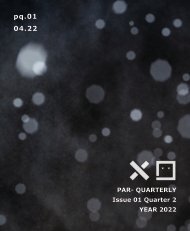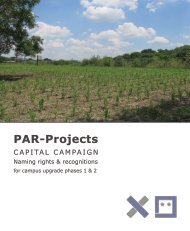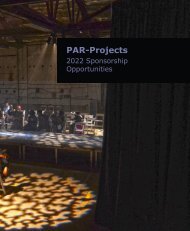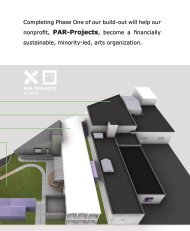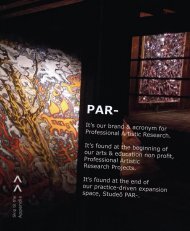PAR- Quarterly Issue O4
PAR- Quarterly Issue O4
PAR- Quarterly Issue O4
You also want an ePaper? Increase the reach of your titles
YUMPU automatically turns print PDFs into web optimized ePapers that Google loves.
PQ.04<br />
04.23<br />
Do you like it?<br />
Marker on maylar paper<br />
18’’ × 25’’<br />
2020
In this quarter,<br />
April 2023:<br />
Beer Burger Brunch<br />
April 30th<br />
Elena Marour<br />
May 20 & p3<br />
Groundbreaking<br />
May 22 & p10<br />
Summer Stage<br />
June 24<br />
Artwork by:<br />
Elena Masrour<br />
Do you like it?<br />
Marker on maylar paper<br />
18’’ × 25’’<br />
2020
experience in which she entered garments in a textile competition, but<br />
her entry was not considered as she photographed her designs on a live<br />
model, a taboo in the Islamic Republic of Iran which polices depictions<br />
of women to ensure images that perpetuate ideals of humility and chastity.<br />
With a new wave of social restrictions beginning in 2014, Masrour<br />
sought other avenues of creative expression and was drawn to traditional<br />
mediums including painting and drawing. Ultimately, faced with limited<br />
opportunities for female artists in Iran, Masrour decided to apply for<br />
Master’s programs abroad including in the United States. Coming to the<br />
U.S opened her eyes to the freedoms for creative expression available to<br />
citizens of this country and underscored her desire to utilize the tools of<br />
artmaking – pen, paper, canvas, and paint – as tools of protest to bring a<br />
voice to her Iranian sisters.<br />
Elena Masrour<br />
was born on May 5, 1990 in Tehran, Iran. She received her BFA in Fabric &<br />
Textile Design from Tehran University of Art in 2013 and received her Master<br />
of Fine Arts in Painting from Kansas State University in 2022. She currently<br />
lives and works in Cleveland, Ohio where she is a visiting faculty-in-residence<br />
at the Cleveland Institute of Art.<br />
Masrour was interested in art from a young age, especially as a legacy artist.<br />
She recalls being ten years old and attempting to copy a self-portrait her<br />
grandfather completed, to her grandfather’s great amusement. In high school,<br />
she was afforded the opportunity to take several elective drawing classes and<br />
soon realized that artist was to be her path in life. At Tehran University of<br />
Art, Masrour initially studied fashion design. However, she encountered great<br />
difficulties in the field, finding few real opportunities for creative enterprise<br />
due to the strict dress code enforced by the Iranian government. She recalls an<br />
Masrour began creating work about the religious propaganda of the Iranian<br />
regime and the social changes that occurred after the 1978 Iranian<br />
Revolution. Her works critique Islamic fundamentalist beliefs that control<br />
women’s lives and limit their freedom including the governmental<br />
policy of compulsory hijab in public spaces. Her works explore weighty<br />
and controversial topics but juxtapose the content with formal inspiration<br />
drawn from comic books, especially those of the Platinum and Golden<br />
age of comics. While Masrour has a fondness for a broad range of characters<br />
including Wonder Woman, Superman, The Hulk, Ms. Marvel and<br />
many other comic staples, one of her most treasured influences is Blondie.<br />
Debuting in 1930 in the New York American daily newspaper, Blondie<br />
depicts not a superhuman woman but rather, a regular woman – a blonde<br />
bombshell who participates in a range of mundane activities unavailable<br />
to the women of Masrour’s home country.
Masrour draws inspiration from her own life as well as the lives of her friends<br />
and loved ones in Iran. In “Help yourself, drink more water” a multi-story<br />
tall female figure, clad in a pink, flower patterned bathing suit squats over<br />
a communal swimming pool. Children and other swimmers lavish in the<br />
idyllic setting, descending water slides and flying kites. The giant female figure,<br />
the heroine of the painting, smiles gaily while simultaneously drowning<br />
a man with her right foot. The piece is inspired by a story from Masrour’s<br />
childhood when she and her family visited the Caspian Sea in 1998. Before<br />
entering the water, her parents explained to her and her brother that they<br />
could not swim together; she and her mother would swim in another area<br />
for the women while her brother and father would swim in a separate area<br />
for the men. She recalls her brother bursting into tears and how her father<br />
attempted to calm him, promising a day full of joy with his peers but her<br />
brother was not persuaded. As the year’s passed, Masrour reflected on this<br />
experience, and she began to realize that “this separation would be applied to<br />
{her} entire social life” in Iran.<br />
Visit<br />
HoffnerStreet.com<br />
for more event info.<br />
or<br />
parprojects.com<br />
for vendor info.<br />
Find a bit more on the <strong>PAR</strong>- Blog: https://parprojects.blogspot.com
But is it honest?<br />
But is it honest?<br />
So when viewing work the ultimate question I ask myself is...<br />
The refreshing thing about this approach is that it helps me make every attempt<br />
to not create any unnecessary roadblocks for entry. No advanced degrees are<br />
required. No references need to be called. No media hype will help or harm the<br />
evaluation process. You either understand the material you’re working with —<br />
preferably for ten years or longer — or you don’t. Because most importantly, you<br />
can’t steal someone else’s playbook to create your truth.<br />
Of course there’s a myriad of factors to consider. For example: Where would the<br />
exhibition fall within our season(s)? Who needs to hear or see the work? How<br />
does the work relate to today’s conversation? The list goes on. But ultimately,<br />
my personal selection process boils down to those simple points, especially the<br />
perspective piece. This helps me ask, are you an artist able to speak your truth<br />
through your work or are you a talented individual who hasn’t yet found their<br />
perspective — your soapbox or place to stand?<br />
It’s simple enough. When asked, my answer is typically along the lines of “…shows<br />
an in-depth knowledge and understanding of the material put forth. It also comes<br />
from an honest perspective.” The question: When selecting artwork to exhibit,<br />
what do you typically look for?<br />
We’re bombarded with imagery, so there has to be more than just a quick reason<br />
to pause. At every corner you can find a con-artist seeking to sell you the next<br />
best idea. They’ll trip you up with flashing lights on mobile stage, but if you choose<br />
too listen closely, you may find a sneeky geenie in the bottle... “By your wish... try<br />
thy dish... buy my hiss.” In our society, to simply cause pause is to create the win<br />
needed to advance... Then a cllick... then a like. Maybe even a follow?.<br />
But is it honest?<br />
To demonstrate how an honest perspective can make or break an opportunity, I’ll<br />
share the Cliff’s Notes version of a recent studio visit I enjoyed.<br />
The artist I’m speaking of is a White male who primarily creates work featuring<br />
his life’s inspirations, often depicting people of color. And yes, even as I type this now,<br />
I feel a certain kind of way. The striking thing is, when I walked into his Indianapolis<br />
studio for the first time, it not only felt inspired, but it felt cultured.<br />
As a quick tangent: Early in my arts training, I was taught that anyone can learn to<br />
realistically draw a figure — it simply takes time, practice, and muscle memory —<br />
but it takes an artist to recreate the soul of a subject.<br />
This unsuspecting artist was finding was to depect the essence of each model he<br />
chose to create an illustration of. Black guys with afros and jolly grins, latino women<br />
with enough body language to control a crowd — each and every image not<br />
only told a story, but did so from a relateable position. That said, I still could not<br />
wrap my head around the the why. But maybe just as important, I still wasn’t sure<br />
if I’d be able to show the work in one of our spaces at <strong>PAR</strong>-Projects. So I asked...<br />
something to the tune of “where does all of this love an admiratin for cultures not<br />
of your own come from?”<br />
His answer was quite simple: Let me show some personal photos real quick. And<br />
with that he ushered me over to living area. There, he went through the photos<br />
that changed his perspective on life. It turns out he has spent many years as a<br />
camp counsler of Black and Brown babies...<br />
Find a bit more on the <strong>PAR</strong>- Blog: https://parprojects.blogspot.com
After of years and years of design and redesign,<br />
we’ve finally been given the green light!<br />
Show. Work. Here.<br />
Join us as we celebrate the<br />
Groundbreaking<br />
for <strong>PAR</strong>- Headquarters!<br />
Calling All Artists<br />
Opportunities Await<br />
qr.par.promo/U6MO<br />
Monday, May 22nd at 4PM<br />
1662 Hoffner Street, Cincinnati 45223







